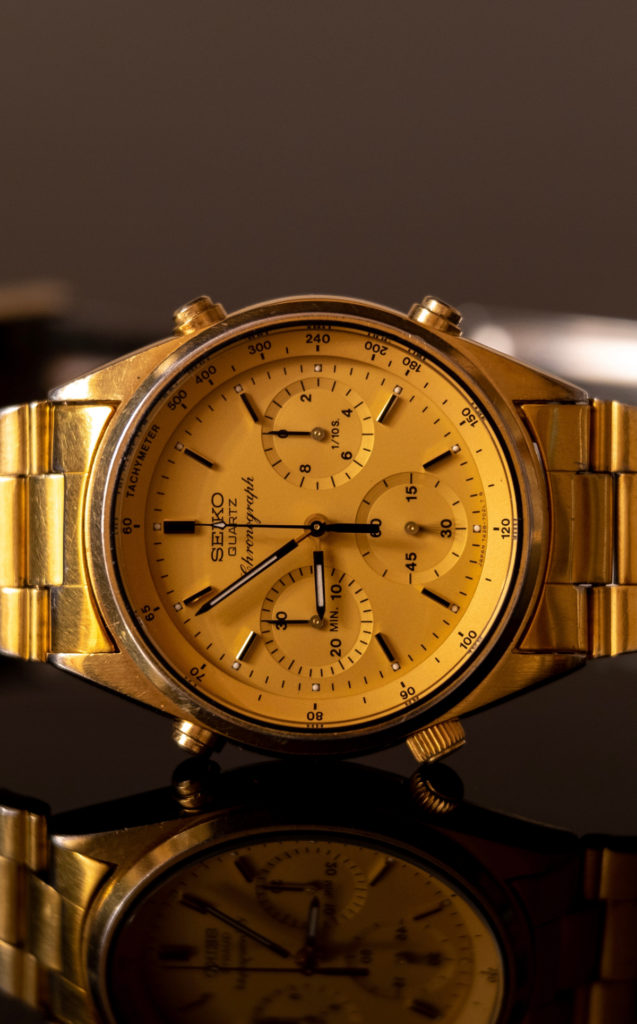Ah, the 1980s. Cruising down Sunset Strip in your Testarossa to catch your reservation at Spago; Barking orders at your broker on your Motorola brick (hopefully buying AAPL by the truckload); And admiring this nice little Seiko 7A28-7029 quartz chronograph on your wrist. This is no ordinary quartz chronograph though. This golden beauty houses the world’s first analog quartz chronograph — and it was kind of a big deal when it came out in 1983.
Unlike the disposable plastic quartz modules common today, Seiko spared no expense with the 7A; An all-metal, 15-jewel movement — intended to be serviced and regulated much like you would a mechanical movement. The Seiko 7A28-7029 watches were marketed as aspirational objects and built to last a lifetime.

The Seiko 7A28-7029 chronograph functions are quite interesting. In addition to the standard start/stop/reset functions, there is a split timer feature that is activated by a third pusher at 10:00. And although the sweep hand only ticks in one second increments, the subdial at 3:00 dutifully scrambles to register every twentieth of a second when the timer is engaged. Upon resetting the timer, the hands do not snap back instantaneously as you would expect on a mechanical chronograph; Controlled by an integrated circuit driving three stepper motors, each hand rotates back to 12:00 in a kind of robotic ballet. Taken together, these would be very expensive complications to implement on a traditional mechanical chronograph, but this is 1983 and the silicon brain now renders all of this moot — if unromantic. I, for one, welcome our new electronic overlords.
The action on the pushers of the Seiko 7A28-7029 have a tactile response unlike any chronograph I’ve ever experienced. They are soft to the push without being mushy — having a firm and satisfying detent that gives you just the right amount of mechanical feedback to assure you of a successful activation. This is of course, artificially created as there is no actual mechanical lever or column-wheel behind that pusher — though it is admirable that Seiko’s engineers paid such close attention to the human experience of the push action.

As interesting as the movement of the Seiko 7A28-7029 is, that vibrant yellow-gold dial clearly thinks it’s the star of the show. Light and shadow play off the sunken registers and stepped chapter ring to give the dial striking dimensionality. Each applied stick marker is finished in black with highly polished golden chamfers that give off an impressive glimmer. The tritium lume is deposited sparingly and precisely into their designated plots and have begun aging to a satisfying butterscotch.
As impressive as the Seiko 7A28-7029 was for 1983, many have spent a lot of time on wrists since then and most examples I see these days are pretty beat up with heavily worn cases and bracelets. The gold PVD coating is usually the most glaring casualty as it tends to wear off with heavy use. This typically affected the bracelet more than the case so swapping to a nice leather strap is an easy enough remedy.
If gold is not your thing, these 7A chronographs came in no less than 42 models, including a stainless steel version worn by James Bond in “A View to a Kill” (7A28-7020), a futuristic model worn by Ripley in “Aliens” (7A28-7000), and a rugged UK military issue (7A28-7120). Whatever your tastes, there’s probably a 7A that’s right for you.


Leave a Reply
You must be logged in to post a comment.